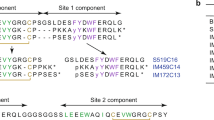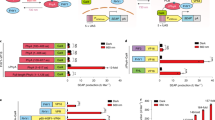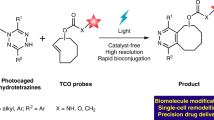Abstract
The first step of insulin's many cellular functions is specific binding to receptors on the plasma membrane of target cells. The subsequent molecular basis of insulin action, particularly the coupling mechanism(s) involved in transmitting the biological message, remains largely unknown1. Our approach to the problem centres on the application of a series of well characterized photo-insulins carrying an aryl–azido or nitro–aryl–azido group in positions A1, B1, B2 or B29 (refs 2–4). Specific binding to membrane components could be demonstrated with B1-, B29- (ref. 5) and A1-photo-insulins6 as well as a B2-derivative7. We now report that lipogenesis is increased to, and maintained at, near-maximal levels for several hours after photoinduced covalent binding of B2- (2-nitro,4-azidophenyl-acetyl)-des-PheB1-insulin (Napa-DP-insulin3) to living adipocytes.
This is a preview of subscription content, access via your institution
Access options
Subscribe to this journal
Receive 51 print issues and online access
$199.00 per year
only $3.90 per issue
Buy this article
- Purchase on Springer Link
- Instant access to full article PDF
Prices may be subject to local taxes which are calculated during checkout
Similar content being viewed by others
References
Czech, M. P. A. Rev. Biochem. 46, 359–384 (1977).
Thamm, P. & Brandenburg, D. in Peptides 1978–Proc. 15th Eur. Peptide Symp., Poland (eds Siemion, Z. & Kupryszewski, G.) 639–642 (Wroclaw University Press, Poland, 1979).
Thamm, P., Saunders, D. & Brandenburg, D. in Proc. 2nd int. Insulin Symp., Aachen (eds Brandenburg, D. & Wollmer, A.) 309–316 (De Gruyter, Berlin, 1980).
Saunders, D., Thamm, P. & Brandenburg, D. in Proc. 2nd int. Insulin Symp., Aachen (eds Brandenburg, D. & Wollmer, A.) 317–325 (De Gruyter, Berlin, 1980).
Wisher, M. H. et al. Diabetologia 15, 282 (1978).
Wisher, M. H. et al. Biochem. biophys. Res. Commun. 92, 492–498 (1980).
Kühn, L., Meyer, H., Rutschmann, M. & Thamm, P. FEBS Lett. 113, 189–192 (1980).
Moody, A. J., Stan, M. A., Stan, M. & Gliemann, J. Horm. Metab. Res. 6, 12–16 (1974).
Gammeltoft, S. & Gliemann, J. Biochim. biophys. Acta 320, 16–32 (1973).
Gliemann, J., Gammeltoft, S. & Vinten, J. J. biol. Chem. 250, 3368–3374 (1975).
Yip, C. C., Yeung, C. W. T. & Moule, M. L., Biochemistry 19, 70–76 (1980).
Pullen, R. A. et al. Nature 259, 369–373 (1976).
Rodbell, M. J. biol. Chem. 239, 375–380 (1964).
Gliemann, J. & Vinten, J. J. Physiol., Lond. 236, 499–516 (1974).
Author information
Authors and Affiliations
Rights and permissions
About this article
Cite this article
Brandenburg, D., Diaconescu, C., Saunders, D. et al. Covalent linking of photoreactive insulin to adipocytes produces a prolonged signal. Nature 286, 821–822 (1980). https://doi.org/10.1038/286821a0
Received:
Accepted:
Published:
Issue Date:
DOI: https://doi.org/10.1038/286821a0
This article is cited by
-
Carbostyril-based beta-adrenergic agonists: evidence for long lasting or apparent irreversible receptor binding and activation of adenylate cyclase activity in vitro
Naunyn-Schmiedeberg's Archives of Pharmacology (2004)
-
Increased phosphorylation of ribosomal protein S6 following microinjection of insulin receptor-kinase into Xenopus oocytes
Nature (1986)
Comments
By submitting a comment you agree to abide by our Terms and Community Guidelines. If you find something abusive or that does not comply with our terms or guidelines please flag it as inappropriate.



